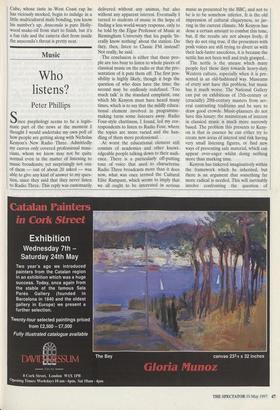Cinema
Kolya
(12, selected cinemas)
Anaconda
(15, selected cinemas)
A fun ride
Mark Steyn
'Ater the Velvet Revolution,' said the Czech director Jan Sverak, explaining what spurred him to make Kolya, 'there was a wave of interest in American cinema for about four months. But people saw they weren't missing anything. They were miss- ing garbage.' He's right, of course, but that doesn't necessarily mean this Czech stuff's any better. The vocabulary of motion pic- tures is American, and foreign films have difficulty finding sustainable alternatives to it: sometimes they disdain Hollywood to the point of narcoleptic perversity (Anto- nioni's ennui-fests), sometimes they recycle its impulses in clever post-modern self- regarding ways (Jean-Luc Godard and a lot of other French cinema); but, either way, they tend to confirm their status as eccen- tric branch lines off the main track. Kolya is even more dependent than that: no matter how much its director protests its superiori- ty, it's constructed entirely from stock Hol- lywood elements — though whether through cunning study of studio schlock or the arrogance of ignorance is hard to say. It's the story of Louka — played by the movie's writer (and the director's father) Zdenek Sverak — who agrees to a quickie marriage of convenience to a Russian and, when she skips, finds himself left holding her baby: a five-year-old boy called Kolya.
Already, the film's trajectory can be dis- cerned: the grudging, selfish, cynical, fatal- istic Louka will grow out of his fatalism, cynicism, etc., and come to love the young boy. But, just in case, the Sveraks make him a classical musician, which always sig- nals seriousness of purpose, and a cellist to boot, which means a mournful, elegiac 'I'd say they got in through the front door.' soundtrack. Throw in a serious illness for the kid, and you're home and dry. This is not to deny that the film has its moments: for example, at the crematorium, when Louka extends his bow towards the woman singing the 23rd Psalm and, instead of goosing her, reaches beyond and pats the young boy. Kolya also has one master stroke: it takes place just before and after the Velvet Revolution, so scenes which would otherwise be merely the lamest Mit- teleuropean transplants of Kramer Vs Kramer are suddenly endowed with huge internalisation-of-the-landscape signifi- cance. The emptiness of Louka's life is symbolic of his country's forlorn, spiritually undernourished stagnation, etc. That's all very well, but it doesn't disguise the film's main deficiency — that what Sverak trum- pets as an antidote to Hollywood clichés is actually a systematic recycling of them. Still, it worked triumphantly: Kolya won this year's Best Foreign Film Oscar and, with a savvy worthy of the natives, the Sver- aks brought a real-life Kolya up on stage with them to accept the award.
Anaconda, on the other hand, is a prime example of what Sverak calls 'garbage', and none the worse for it. You know when you're washing the car and the water pres- sure's too high and the hose jumps off the tap and whips across the gravel at you? Well, that's what they're up against here: a 40-foot garden hose with fangs, who's the nearest thing to a credible performance in the picture. Up the Amazon come the usual doomed ensemble, destined to be killed off in reverse order of their billing.
The core crew are cast with the meticu- lous computerised diversity of an American television news show: there's a white guy (Eric Stoltz), an Hispanic woman (Jennifer Lopez) and a beefy black guy (the rapper Ice Cube: in the news show, he'd be the weatherman). Further down the roster are a girl who screams and a Brit asshole. Play- ing a snooty English documentary presen- ter, Jonathan Hyde makes his entrance by imperiously demanding that the girl carry his bags aboard. 'Pompous ass,' she whis- pers, in case we haven't twigged. He chips golf balls to his favourite operatic arias and sips tea insouciantly, as their boat glides up river past semi-submerged statues of men being throttled by snakes. They are in search of something called the Shilly-Shally tribe, but make the mistake of picking up Jon Voight en route. Leathery-skinned, pony-tailed, squint-eyed Voight is, inevitably, a Paraguayan priest turned snake-hunter. But he knows the Shilly- Shally — or, as he calls them, 'dee pipple o' dee meest'. Voight's accent is by far the most lavish special effect in the film: `Iss bin ay bong taym seence ay hayd a wooman,' he tells Jennifer Lopez.
From then on, the most interesting ques- tion is how long the pompous English ass will last. As his various colleagues are throttled, eaten and disgorged, he proves surprisingly resilient. But, when he and Ice Cube, whose taste in West Coast rap he has viciously mocked, begin to indulge in a little multicultural male bonding, you know his number's up. Anaconda is pure Holly- wood snake-oil from start to finish, but it's a fun ride and the camera shot from inside the anaconda's throat is pretty neat.



































































 Previous page
Previous page